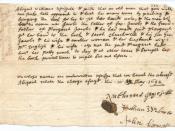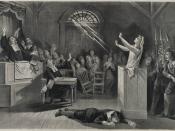The Crucible
In the past, present, and undoubtedly in the future, deceptive individuals take advantage of the anxieties and fears of society. When a society's insecurities are exposed and raw, a disconcerted mood spreads throughout the people. This contagion can engulf an entire population and become like a living entity, causing people to act rashly and hypocritically. Whether or not the fear is justified, a convincing individual can exploit a certain mentality called mob psychology. Mob psychology involves manipulating the hysteria of a crowd to fulfill one's desires. In Arthur Miller's The Crucible, Abigail Williams and other characters spread a fear of witches in the Puritan town of Salem. The fear that they spread ends up permeating their community and dominating the lives of everyone in the town. The psychological phenomenon known as mass hysteria has an important effect on the events in The Crucible.
The Crucible contains many important events that precede the madness that ensues by the end of the play.
Abigail Williams, for instance, has a love affair with John Proctor, and wants Proctor to leave his wife Elizabeth for her. Another character with a hidden agenda is Mr. Thomas Putnam, who hopes to take over some of his neighbor's land. To amplify the situation, a group of girls are questioned by ministers for performing witch-like rituals in the forest. A Puritan belief of the 17th century is that the devil and other demons live in the forest, and that witchcraft is performed there as well. Dissembling citizens begin to accuse others of witchcraft, with a very selfish motive. As John Proctor describes the
hysteria that ensues,'vengeance is walking Salem' (1079). The vengeance that Proctor is talking about is the motive for all the accusers. The accusers are able to get away with injustices in the...


